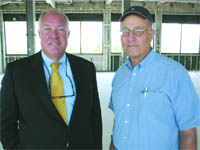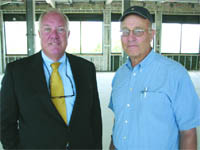
Beyond Recognition
60 Congress St. Gets a Facelift and a Clean Slate

Bob Greeley, left, and Zane Mirkin say the accessibility of 60 Congress St. should help fill the building, even in a down economy.
While speculative building is certainly risky in this economy, Zane Mirkin and Jerry Gagliarducci thought they were on solid ground when they acquired 60 Congress St., aka the Hooters Building. Theyre off to a strong start with the signing of the Pioneer Valley Planning Commission as lead tenant, and believe they can fill whats left quickly due to the buildings great location and a facelift that is making its past use a distant memory.
Bob Greeley calls it changing the mass.
Thats a development industry term (sort of), he said, that is used to describe the process of dramatically altering a buildings appearance so that no one will know what it was before or care.
To say that the mass has been changed at 60 Congress St. in Springfield would be a real understatement, at least in light of some the anecdotes shared by Greeley, president of the R.J. Greeley Co., who helped orchestrate this highly visible project.

60 Congress St. before, during, and after.
Ive had a lot of people ask me if this a new building, he said of the structure, which was built nearly a century ago and has seen a number of uses, including, most recently, home to a certain chain restaurant noted for its provocatively dressed waitresses. And one person said to me recently, this was the Hooters building?
Thats exactly the kind of comments Greeley and the two partners/developers in this endeavor, Zane Mirkin and Jerry Gagliarducci, had in mind when they demolished one section of the four-story structure, completely gutted what was left, built a small addition, and put on a new façade.
Actually, the real goal was and is to remove the phrase Hooters building from the local lexicon and sooner rather than later.
We certainly dont use that term anymore, said Greeley, referring to those at his firm who call it simply, 60 Congress St. He believes that with time, and perhaps not much of it, that will become the name commonly used in Greater Springfield. And to help move matters along, the developers have affixed the numeral 60 (five feet high) to all four sides of the building.
They can be seen by a great many people, said Mirkin, president of Associated Building Wreckers, who, while offering a tour of the facility along with Greeley, gestured with his hand while looking out huge windows facing south, west, and north. With that view, people can see cars traversing Routes 91 and 291, as well as Main Street and other major arteries. This is a very visible, very accessible site.
It is this attractive location that inspired Mirkin and Gagliarducci to undertake what amounts to speculative development at the height of the worst recession in 70 years, and it prompted optimism from Greeley as he discussed the task of filling the remaining space.
The Pioneer Valley Planning Commission (PVPC) has taken the first two floors, or roughly 60% of the 30,000 square feet available, and Greeley says theres been a good deal of interest in floors three and four, which can accommodate one or several tenants each within their 6,000 square feet.
Weve had some interest from the medical sector, he said, noting that there are many medical offices within a few blocks of the building, as well as the close proximity of Baystate Medical Center and Mercy Medical Center. But were seeing it from many other sectors as well; Ive had a lot of calls.
New Lease on Life
Recalling his Springfield history, Greeley told BusinessWest that 60 Congress St. was long home to the American Linen Supply company and was the only building in a three- or four-block area of the North End not to be razed during what became widely known as the bulldozer era of urban renewal in the early and mid-1960s.
It managed to survive all that somehow, he explained. It was a solid building, in pretty good shape so they let it stand.
More than four decades later, its still there, although no one would recognize it which is exactly the point of the exercise undertaken by Mirkin and Gagliarducci, president of Gagliarducci Construction, with a little coaxing from Greeley.
He has worked with those businessmen on several commercial real estate developments in Greater Springfield, and saw, in 60 Congress St., what he considered another excellent opportunity.
Greeley told BusinessWest that he had been chasing the building for some time, meaning that he had been monitoring the situation the building had been vacant for some time after Hooters and another restaurant on that site closed down and watching for circumstances to come together for practical reuse.
He approached Mirkin and Gagliaducci to discuss what he considered to be vast potential at the site, but said he really didnt have to sell them on the idea.
Instead, it pretty much sold itself, he continued, adding quickly that, despite some structural challenges and the softened economy, the property had what he called all the right ingredients for success, including visibility, accessibility, and abundant on-site parking.
Together, these provided more than enough selling points for Mirkin and Gagliarducci, who prevailed at the second of two auctions on the property roughly a year ago.
This would become latest in a string of real-estate endeavors for the two partners. They came together for a development of an office complex on Dwight Road at the Longmeadow/East Longmeadow line, and also on a property on Brookdale Drive in Springfield that became home to Branford Hall. They also worked together on a project involving a former Peter Pan bus-repair facility on Arnold Avenue in Springfield.
What the two saw in 60 Congress St. was a chance to breathe some life into a North End landmark that had somehow fallen into dormancy, and they took what amounted to a considerable risk given the economy and a soft real-estate market that has flooded the region with vacancies and for-lease signs.
But they were helped tremendously by the plight of the PVPC. The agency had been located on the top floor of the municipal office building in West Springfield for more than 20 years, but was informed in 2007 that the city needed that space. It was only a few months after Mirkin and Gagliaducci purchased the building when talks commenced about the agency about moving to that address.
By then, the partners had already engaged the architectural firm Caolo & Bieniek and Saloomey Construction Co. to design to execute this changing of the mass that Greeley described.
A small portion of the original structure was demolished, and a new entrance element, featuring an elevator, stairwell, and common space, was added. A number of structural changes were made to bring the 99-year-old edifice up to modern building codes (earthquake-proofing it, for example), said Mirkin, and the property was essentially gutted to its four walls.
The signing of the PVPC as the primary tenant provided a real sense of urgency and moved matters along very quickly, said Greeley, noting that the developers set and met an aggressive timetable to have the agency moved in by Sept. 1.
As for the task of filling the remaining space, Greeley told BusinessWest that he had been reluctant to show prospective tenants a work in progress or architects renderings of what a renovated 60 Congress St. would look like. But now that the work is essentially completed, hes making up for lost time.
I wanted to wait until it was finished, he explained. Its hard to sell people on a drawing. Now that people can see whats been done, it will be much easier to sell them on this address.
Success Stories
As he walked across the fourth floor of 60 Congress St., admiring the views of downtown Springfield that it provides, Greeley conjectured that it wouldnt be long before the top two floors of the building which have gone virtually unused for two decades would again be teeming with activity.
And by then, the phrase Hooters Building should be that much closer to being a term out of use.
Thats what happens when a buildings mass is changed not to mention its fortunes.
George OBrien can be reached at




